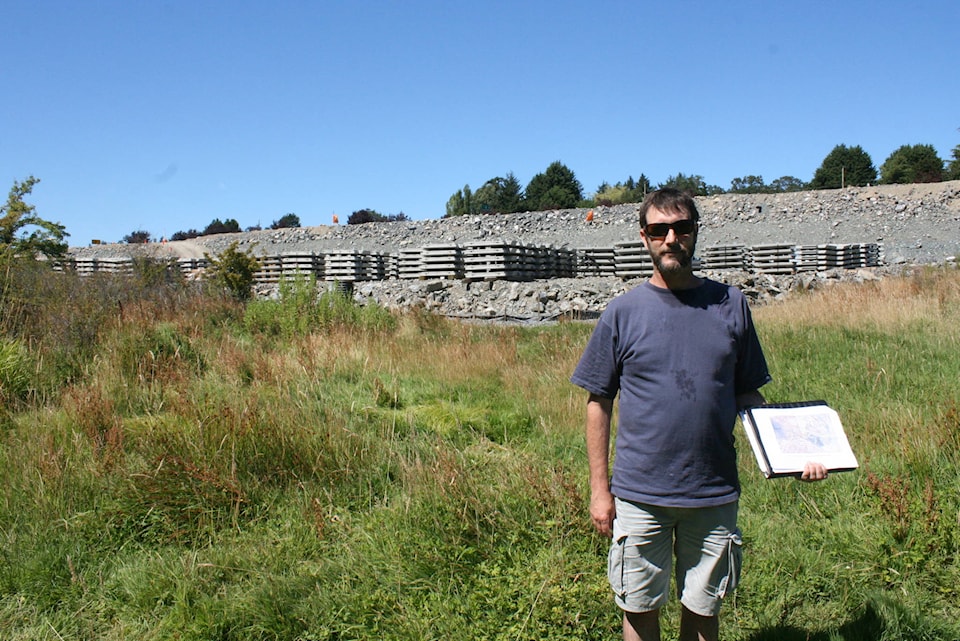A prominent defender of Cuthbert Holmes Park does not oppose provincial plans for a highway berm in principle, but questions the current proposal.
“I don’t like their plans for the berm,” said Julian Anderson, lead steward for the Friends of Cuthbert Holmes Park. “I’m not against the berm in principle. I think it has potential to buffer the sights and sounds of the highway. But I’m not crazy about their plans as first proposed and I would like to see them negotiate something smaller and more appropriate for the park.”
Anderson made those comments while on a tour through parts of Cuthbert Holmes Park, where it bumps against the McKenzie interchange project. It is an $85 million project by the provincial government to ease congestion at the intersection of McKenzie Avenue and Highway 1 through a partial ‘cloverleaf’ ramp system that also includes features designed to benefit cyclists and transit riders. Construction started in the fall of 2016 and the project is scheduled to be complete by late 2018.
The project has generated considerable controversy from its start. Groups representing community and environmental interests have joined area politicians to express concerns about the environmental and social effects of the project.
Following the start of construction, the provincial government announced the addition of a 500-metre long highway berm running north-south on the western side of Highway 1. It will begin just south of Admirals Road, terminating north of Tilicum Road. Half of the berm will run parallel to the Colquitz River.
The Ministry of Transportation and Infrastructure plans to build the berm out of soil that constructions crews are currently excavating to lower the highway. The ministry said in a presentation this March that the berm will cut transportation costs and greenhouse gas emissions, while serving as a visual and sound buffer between the highway and Cuthbert Holmes Park.
Anderson’s specific concerns include, among others, the height of the berm. Its southern end will be 14 metres above the existing ground level or 11 metres above the highway.
“I think that is just a little bit too big,” he said. “The slopes will be very steep and it will be tough to maintain. You can’t get a mower on to [take out] the invasive [plant] species that will no doubt pop up.”
The greater the slope, the less stable the berm would be, a concern given its proximity to the Colquitz River, a salmon-bearing river, he said. It would also be more difficult to stop the spread of evasive plant species from the berm into the park, he said.
Anderson raised some of these concerns last week in a presentation to Saanich council, which will have to sign off on ministry plans. He said during his presentation that the ministry’s efforts to stabilize the slope by planting vegetation are insufficient.
“They have proposed 160 plants for this berm, which is 500 metres in length. That is less than one plant for three linear metres, so that is woefully inadequate for the task at hand.”
Anderson said the ministry also lacks an effective invasive plant management plan.
“They apparently will be expecting Saanich to deal with this, because they had told me that their evasive species management [plan] will end once the project is completed,” he said. “The unfortunate thing is that is exactly where the problems start, and invasive species thrive on disturbed soil.”
Mayor Richard Atwell and the rest of the council received the report. “It is not painting a very rosy picture,” he said.
Janelle Erwin, Ministry of Transportation deputy director, south coast region, said in an earlier interview that the design for the berm is not yet final and several aspects of the proposal may change. The management of invasive species on the berm also remains open for negotiations. While the province will not look after the berm in “perpetuity,” several ways exist for the provincial government to participate, she said.
Anderson appeared to reserve final judgment about some of these claims during Sunday’s tour in reiterating concerns about the ministry’s performance so far.
He specifically pointed to the ministry’s initial failure to acknowledge that part of the project had violated a 30-metre buffer.
“At the cloverleaf, they promised a 30-metre buffer between the project footprint and the [Colquitz River] and after several denials, they admitted that they have encroached on that buffer, but they are still minimizing their responsibility for that and the size of the encroachment,” he said.
While the ministry “talks the talk,” their follow-up is lacking, he said. “So when it comes to berm that they are proposing, I don’t know how we can take them at their word.”
In an earlier interview, Erwin confirmed a “small area of overlap” between the buffer and the project at its southern end. The ministry has since hired a third-party consultant to develop a plan for additional enhancements to the affected riperian area, a Colquitz River tributary, said Erwin.



